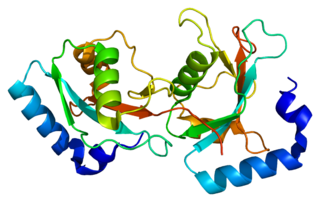Autophagin-1 (Atg4/Apg4) is a unique cysteine protease responsible for the cleavage of the carboxyl terminus of Atg8/Apg8/Aut7, a reaction essential for its lipidation during autophagy. [1] Human Atg4 homologues cleave the carboxyl termini of the three human Atg8 homologues, microtubule-associated protein light chain 3 (LC3), GABARAP, and GATE-16. [2]

Cysteine (symbol Cys or C; ) is a semiessential proteinogenic amino acid with the formula HO2CCH(NH2)CH2SH. The thiol side chain in cysteine often participates in enzymatic reactions, as a nucleophile. The thiol is susceptible to oxidation to give the disulfide derivative cystine, which serves an important structural role in many proteins. When used as a food additive, it has the E number E920. It is encoded by the codons UGU and UGC.

A protease is an enzyme that catalyzes proteolysis, the breakdown of proteins into smaller polypeptides or single amino acids. They do this by cleaving the peptide bonds within proteins by hydrolysis, a reaction where water breaks bonds. Proteases are involved in many biological functions, including digestion of eaten proteins, protein catabolism, and cell signalling.

Autophagy is the natural, regulated mechanism of the cell that removes unnecessary or dysfunctional components. It allows the orderly degradation and recycling of cellular components.
The rapid advancement in our understanding of the mechanisms and regulation of autophagy has placed this process in the center of current research in major human disorders. [3] The future challenge is to develop easy methods to separately manipulate the activity of each of the autophagic pathways. This would allow researchers to further understand their contribution to disease such as cancer, neurodegeneration, infectious disease, muscular disorders and possibly will provide therapeutic tools.

Cancer is a group of diseases involving abnormal cell growth with the potential to invade or spread to other parts of the body. These contrast with benign tumors, which do not spread. Possible signs and symptoms include a lump, abnormal bleeding, prolonged cough, unexplained weight loss, and a change in bowel movements. While these symptoms may indicate cancer, they can also have other causes. Over 100 types of cancers affect humans.

Neurodegeneration is the progressive loss of structure or function of neurons, including death of neurons. Many neurodegenerative diseases – including amyotrophic lateral sclerosis, Parkinson's disease, Alzheimer's disease, and Huntington's disease – occur as a result of neurodegenerative processes. Such diseases are incurable, resulting in progressive degeneration and/or death of neuron cells. As research progresses, many similarities appear that relate these diseases to one another on a sub-cellular level. Discovering these similarities offers hope for therapeutic advances that could ameliorate many diseases simultaneously. There are many parallels between different neurodegenerative disorders including atypical protein assemblies as well as induced cell death. Neurodegeneration can be found in many different levels of neuronal circuitry ranging from molecular to systemic.












